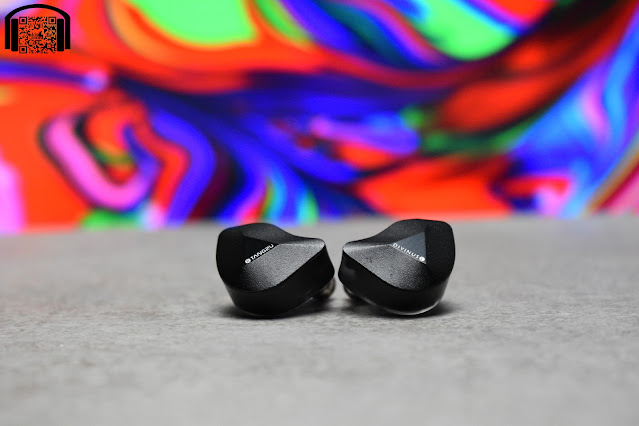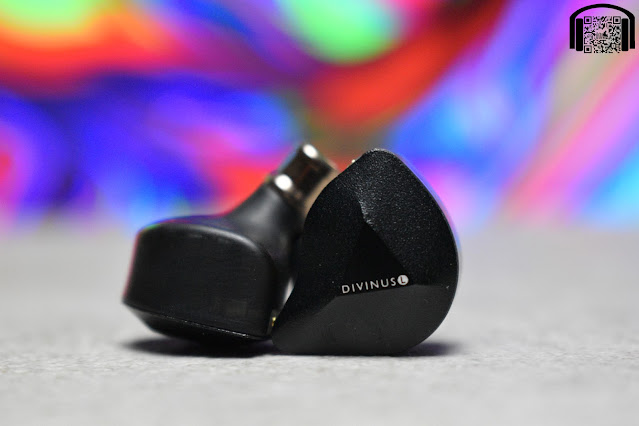- Get link
- X
- Other Apps
English | Español
TLDR version on YouTube: TDLR - Tangzu x Divinus Fudu Verse 1
The Tangzu x Divinus Fudu Verse 1 have been sent to me by Linsoul in exchange for the publication of my review. Linsoul have not requested anything and, as always, I will do my personal best to be as unbiased as humanly possible.
You can find the Fudu Verse 1 via Linsoul here: https://www.linsoul.com/products/tangzu-fudu-verse-1
As with all the links I publish, this is a non-affiliate link, meaning I do not receive anything in exchange for clicks or purchases via the link.
To avoid being repetetive in my reviews, you can find all the info about how I create the reviews, equipment used, how I receive the products and how to interpret my reviews by visiting: About my reviews
Intro…
Tangzu x Divinus Fudu Verse 1… that is certainly a long name! Tangzu seem to have a tradition of adding verses and chapters to their IEMs, so my guess is that there will be a follow up to these IEMs (which I am going to refer to as Fudu for brevity).
I originally reviewed Tangzu before they were actually Tangzu (they were called T-Force at the time) and I have to say that they have made some interesting sets. I felt that the Tangzu Wan’er were a great set of IEMs in the sub 20€ bracket, well, they still are, although there is a lot of competition in that price bracket.
The Fudu are in a slightly higher bracket, selling for around 80€ on Linsoul at the time of this review, and while this puts them outside my personal ultra budget limit of 50€, they are still not an expensive set of IEMs.
The Divinus part of the name comes from the collaboration with the brand (Divinus) who make ear tips. I have never tried, or heard of, Divinus tips (until now) but it seems that they are well known amongst other IEM users.
So, let’s take a look at this latest release from Tangzu and see what we get from the brand that has given me positive vibes in the past.
Presentation…
Tangzu is pretty generous with the contents of (most of) their models, with packaging that usually focuses on traditional Chinese decor. In this case, we still get a hint of that Chinese traditionality on the box but much more subdued than their usual packaging.
A rather large black box is covered with a black sleeve showing greyscale clouds and birds in the background and white model name and branding on the front. This simple presentation does give the packaging a bit more of a more elegant look (in my opinion) than many other presentations from the brand.
Opening up the box, we find the IEMs in a cardboard and foam cutout in the center, with 3 sets of Tang Sancai tips and 3 sets of Divinus tips to the left. On the right we get a (faux) leather case with zipper closure that reminds me more of my grandmothers coin purse than an actual IEM case. Inside the case (purse?) we find the cable which, in my case, is terminated with a 4.4mm balanced connector, although 3.5mm unbalanced is also available.
The presentation in general is not remarkable but is good, with a selection of contents that may not be the most vast at the price point but does seem to be of quality.
Build and aesthetics…
The IEM shells are 3D printed resin with a very dark tint, allowing just a hint of the internals to be seen. On the front of the shell they feature a metal faceplate that shows Tangzu on the right earpiece with Divinus on the left.
The IEMs are small and light, using a pretty generic shape, which should work for the majority of people out there. Personally I have not experienced any discomfort. The faceplate has sloped surroundings that aim to a triangle in the center (where the branding is shown in white). I can’t say that they are going to win any prizes for their beauty but they are not overly dreary, just a little simple.
The included cable works fine but does have a bit of a cheap feel to it. It is also a little bit “springy”, although this may reduce over time with use. As I have been using them at my desk, the cable hasn’t really moved a lot, so it still has that new springyness to it.
The included Sancai tips are tips that I received with a previous set and find quite nice. They have a textured finish to them and, while they are not my number one prefence, I have found that they work well with some IEMs that I find overly bassy. The Divinus tips have been a pleasant surprise and I feel that they work well with the Fudu (I haven’t tried them on other IEMs yet), improving the sound at both ends of the spectrum (to my ears).
Sound…
All tracks mentioned are clickable links that allow you to open the reference track in the streaming service of your choice (YouTube, Tidal, Qobuz, Spotify, etc.)
There is a noticeable difference between the 2 kinds of included tips, with the Divinus moving a bit of the low end presence towards the subbass region instead of the midbass (although midbass is still very present) and seemingly giving things a bit more sparkle in the upper ranges. These have been my preferred choice for the Fudu.
My measurements, as always, are taken with foam tips to keep consistency between models, so the frequency response will not match exactly with the included choice of tips but is still pretty close:
Starting off with the low end, here I found the tips to play quite a large role in the presentation. Well, tips always play a big role, but in the case of the Sancai vers the Divinus, I found that the latter placed a little more emphasis on the subbass ranges, making the midbass area seem a little less prominent, whereas the Sancai took a little away from the subbass, making the midbass be more of the center of attention in these low ranges.
Using my typical “Chameleon” as a test track, there is enough subbass with both of the tip choices, yet, as the Divinus move the attention a little further down, it doesn’t seem to be as overpowering as with the Sancai tips. Overpowering is maybe the wrong term, as it is not like these IEMs are bass monsters, but as someone who prefers a less boosted midbass range, I found the Divinus to work better in this regard.
The same goes for more electronic focused tracks, with things like “No Sanctuary Here” being more to my preference with the Divinus tips.
In general the bass range is rather smooth and relaxed rather than fast and detailed, something that holds true for the rest of the frequency ranges also, with these IEMs giving a more relaxed and rounded presentation in general.
I don’t find the midbass to be overly boomy but it is still a little north of my preferences on tracks like “Crazy” by Daniella Andrade. The bass region of the guitar is pretty smooth and while I would like a little more detail on other tracks, for this kind of music it is not something that stands out.
The midrange is pretty decent until we start to get into the higher end of it. There is a climb in the upper midrange frequencies that serves to bring the presence a little forwards, however, at the 2kHz mark it stops climbing, even rolling off a little, until suddenly we have a peak around the 4kHz mark.
The issue with this is that it brings vocals forwards so they are not lost (counteracting that additional midbass), however, that isolated peak at the 4kHz mark, followed by another prominent dip, makes vocals sound fragile to my ears. I found this to be the case both with male vocals, such as John Mayer in “Free Fallin’”, and female vocals, such as Daniela Andrade in the song “Crazy” that I already mentioned. In fact, on “Billie Jean” by The Civil Wars, both vocals (male and female) sound a little thin and fragile, even impacting the higher ranges of the acoustic guitar.
As we move into the higher frequencies, this is another point where the tips are most noticeable in their changes. Here I once again preferred the Divinus with the Fudu, as they make things sound a little airier and spacious in these ranges. With the Sancai tips I would say that the upper ranges are a little too rolled off for my tastes, yet with the Divinus I feel that they are much better balanced.
Sound stage is also improved with the Divinus, becoming quite decent for a set of IEMs. It is not a huge difference from the Sancai but it is noticeable and I would say that they are on the higher end of average with these tips.
One thing that is noticeable throughout the whole spectrum is that detail is not the forte of the Fudu. They have used that 4kHz peak to make things a bit clearer and also the Divinus tips help by making the upper ranges seem more alive, however, this just adds a false sensation of detail.
Conclusion…
I can’t say that there are any glaring issues with the Tangzu x Divinus Fudu Verse 1 (I’m glad I abbreviated it to Fudu throughout the review 😉 ) but I can’t say there is anything spectacular about them either.
They are a decent performing set of IEMs but, in my opinion, they have tried to make up for a lack of detail by using that 4kHz peak, along with a couple more peaks throughout the treble.
I really don’t think it was necessary for them to do this, as I don’t feel that all IEMs should be detail monsters. Sometimes we just want IEMs that are musical and provide us with enjoyment and I think the Fudu would be great for this if it wasn’t for things becoming “fragile” with that intent to seem more detailed.
Again, I can’t complain about them, I think they are a set of IEMs that can be very enjoyable with just a little tweaking of EQ (or maybe some kind of filter in the nozzle to tame that peak) but I also can’t say that they are amazing.
All FR measurements of IEMs can be viewed and compared on achoreviews.squig.link
All isolation measurements of IEMs can be found on achoreviews.squig.link/isolation
To comment or contact, visit any of the following social media platforms:







